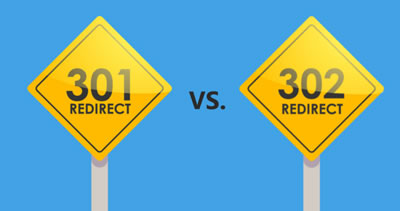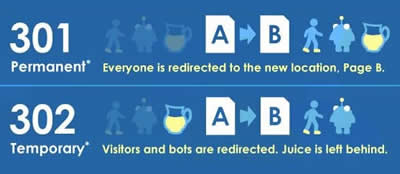Difference between 301 and 302 Redirect
Key Difference: 301 Redirect is simply the code to tell the web browser that the website has shifted to a permanent new location. The 302 Redirect code tells the web browser that the website has temporarily shifted to a new location.
 Digital marketing comes with a lot of facets and often trying to figure out the entire thing in one go can be difficult. With Google setting standards and changing them depending on the trends, a lot of webmasters are left more confused. 301 vs 302 redirects is one such topic, and most commonly because both are responsible for redirecting a website from one URL to another.
Digital marketing comes with a lot of facets and often trying to figure out the entire thing in one go can be difficult. With Google setting standards and changing them depending on the trends, a lot of webmasters are left more confused. 301 vs 302 redirects is one such topic, and most commonly because both are responsible for redirecting a website from one URL to another.
Let’s take a closer look at what redirects are and how 301 and 302 differ from each other.
HTTP Response Status Codes are ideally designated numbers that tell the web browsers and servers what to do with a particular URL. The most popular code is the 404, or “Page Not Found”. The other codes such as 301 and 302 are more familiar and important for web masters and marketers.
301 Redirect is simply the code to tell the web browser that the website has shifted to a permanent new location. The 301 Redirect code permanently redirects the location of a website from one URL location to another automatically. The redirect ensures that in addition to the website, the page ranking as well as the link juice is also transferred to the new URL. This ensures that the website doesn’t have to start from scratch. This is more commonly used when a website has changed their name and domain name. Another reason for using a 301 redirect is if you generate an URL that is wrong or has an error, so you can ensure that you don’t end up with a 404.
 Now, the 302 Redirect code tells the web browser that the website has temporarily shifted to a new location. The 302 Redirect code temporarily shifts the location of a website from one URL to another automatically. Since the move is temporary, the redirect does not shift the ranking or link juice to the new location – simply the website. 302 is more commonly used by e-commerce websites who sell seasonal products that may be out of commission once the season is over. Another place where this redirect can be used is when you are working on website maintenance, so if you don’t want to shut down your website completely, you can simply redirect it for a while.
Now, the 302 Redirect code tells the web browser that the website has temporarily shifted to a new location. The 302 Redirect code temporarily shifts the location of a website from one URL to another automatically. Since the move is temporary, the redirect does not shift the ranking or link juice to the new location – simply the website. 302 is more commonly used by e-commerce websites who sell seasonal products that may be out of commission once the season is over. Another place where this redirect can be used is when you are working on website maintenance, so if you don’t want to shut down your website completely, you can simply redirect it for a while.
Both redirects play an important part in marketing and website maintenance. Also, a lot of time people often end up using 302 redirect instead of 301, creating more problems for themselves and web browsers. That is why, before you go for redirects it is important to know what type of redirect you need for your website. Because, a 301 redirect is a bit more complicated to create than a 302. Also, if your websites has more 301 redirects, it can result in your website slowing down, so you should use it carefully.
Comparison between 301 and 302 Redirect:
|
|
301 Redirect |
302 Redirect |
|
Definition |
Redirects the location of a website from one URL to another |
Redirects the location of a website from one URL to another |
|
Types of Server Redirects |
HTTP code redirect |
HTTP code redirect |
|
Type of Move |
Permanent |
Temporary |
|
How to create the redirect |
Special commands in your .htaccess file if you use an Apache server |
Use Javascript or a meta tag to create a 302 |
|
When to Use |
Commonly used when domains names are changed. If your website is growing but you want to change your company or website name, then to retain your customers and users, you can shift your entire website to your new domain name without losing your ranking Can also be used in case of break in your URL |
Most commonly used in e-commerce when there are seasonal products. So, when the product is out of stock or out of season, a redirect can be used to send the viewer to another location on your website |
|
Page Rank & Link Juice |
Passes the Page Ranking and the link juice from the old URL to the new one |
Does not pass Page Ranking and link juice from the old URL to the new one |
Reference: LTnow, Hochman Consultants, YouTube – Neil Patel, SEOblog, Search Engine Journal, MOZ, SEOClarity Image Courtesy: seoblog.com, searchenginejournal.com









Add new comment